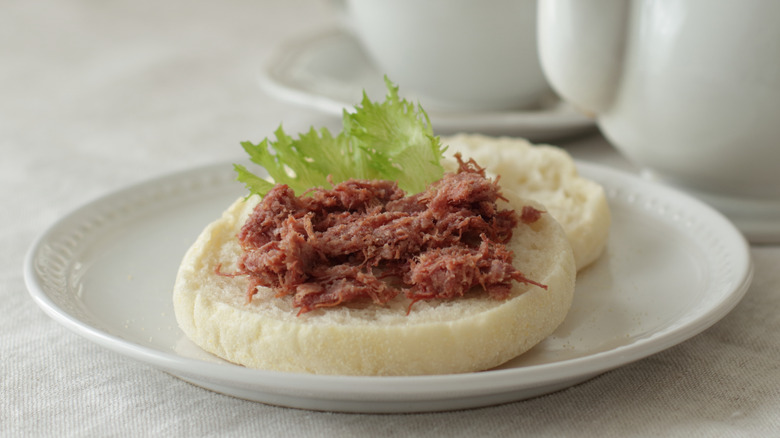Don't Skip This Step Before Eating Canned Corned Beef
For some people, it's a once-a-year holiday delicacy. For others, it's a near-daily obsession. Love it or hate it, corned beef has a special place in food culture around the world. Once England began canning it in the early to mid 1800s, that only improved its reach to every continent, and it's still a staple of many cuisines today. If you're someone who isn't a huge fan, there may be a reason it doesn't tickle your fancy — you're preparing it wrong!
The essential first step in prepping canned corned beef is to rinse it. Yes, with water. It may seem weird to wash canned meat, or any meat really, but it's a surefire way to get the best flavor out of it. Canned corned beef is preserved and packaged in a brine, which contains a massive amount of salt. Because of this, the salty flavor leaks out into all other ingredients when you cook with it, making everything it touches taste a little briny. Washing the meat gets rid of much of that sodium, leaving you with a less salty punch that you can modify with other spices and flavors. In other words, rinsing corned beef is a chef-level tip for fixing salty food, making it a far more versatile ingredient.
That's a lot of salt
You might be wondering exactly how much salt this process removes. Maybe you're a big fan of the super salty flavor, and you don't want to ruin it. Not to worry — canned corned beef has more than enough sodium to go around.
The "corned" in "corned beef" doesn't come from any actual corn. Instead, it originally required grains of salt that were as large as corn kernels during preparation. While the methods have changed somewhat, canned corned beef still often contains 20% or more of your daily sodium in a single serving. Most cans contain multiple servings, so you could end up eating all of your daily recommendation of salt in one sitting, if you're not careful. A large portion of that sodium is contained in the brine, so you can get that number way down with just a little rinse.
While soaking or rinsing the meat, break it up with a fork or knife so that water can penetrate it properly. You can submerge it entirely in a pot of water to soak it from two to 72 hours, or rinse it several times under running water for faster prep. Once that's done, make sure to pat it dry to remove any excess liquid before cooking. Finally, you're ready to add spices, sauces, or even additional salt if you'd like. Still, considering that we're all probably eating too much salt already, a little less sodium in your diet is probably a good thing.
The versatility of corned beef
Now that you have some less-salty corned beef to work with, it's time to figure out your favorite way to eat it. If you're considering corned beef versus pastrami, corned beef is great for more than just sandwiches — and you can look to various parts of the world where it's prepared in all sorts of different ways.
Corned beef and cabbage is a Saint Patrick's Day dinner classic in the United States, but Jamaican "bully beef" is a comfort food that's served all year round, especially during storms, or other times of limited resources. For breakfast, corned beef hash is a warm and hearty way to start your morning, originally hailing from Ashkenazi Jewish culture. In the Philippines, corned beef is often used in savory soups, or fried into omelets and fritters. Of course, if you want to keep things simple, you can always slice it up and make a corned beef sandwich with mustard like they do in England. Whatever you decide, rinsing your canned corned beef is a vital first step.


